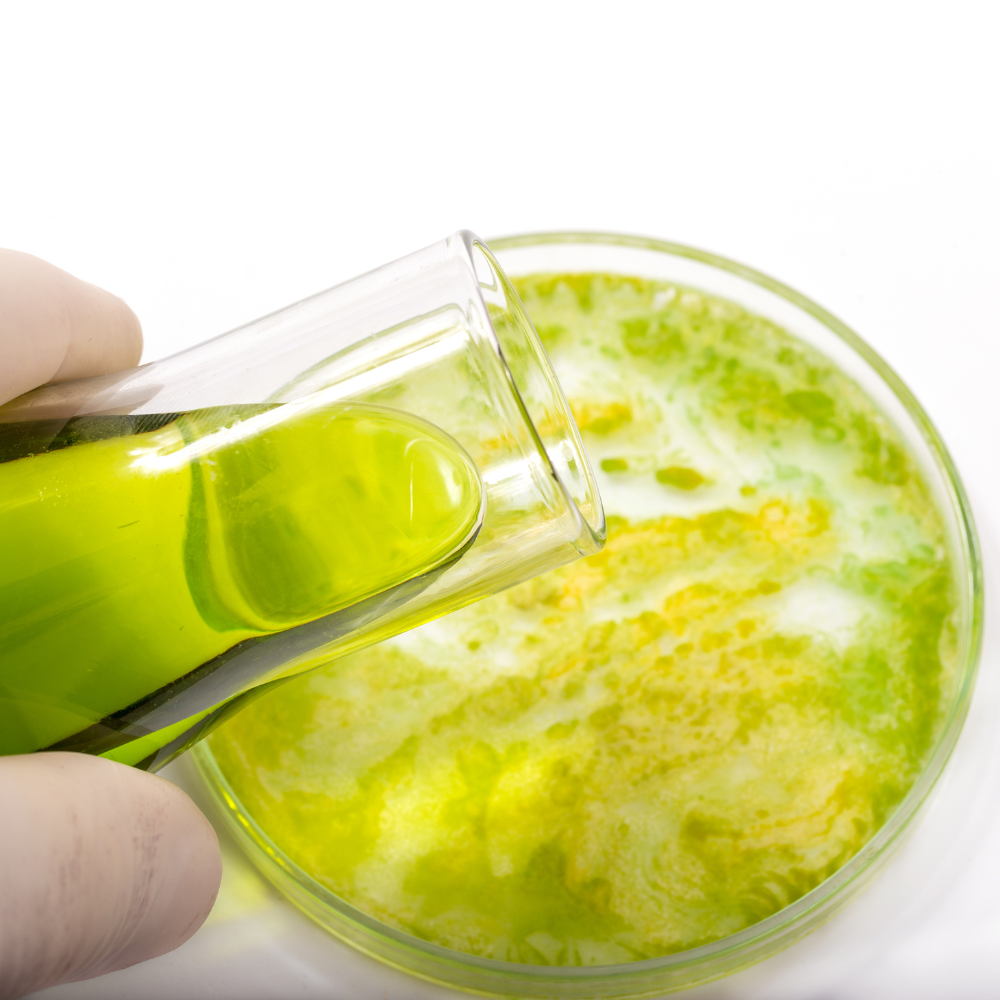Your cart is currently empty!

Getting Started
Overview
So you’ve received your new Live Phytoplankton Culture and you’re ready to start culturing right? In this article, we will review the necessary steps required to successfully culture Nannochloropsis and Tetraselmis Phytoplankton!
What You’ll Need
- Culturing Vessel
- Grow Light
- Air Pump
- Air Line Tubing
- Guillard’s F/2 Fertilizer
- Isopropyl Alcohol
- Measuring Syringe or Pipette
- Live Phytoplankton Culture (Nannochloropsis or Tetraselmis)
- Freshly mixed Marine/Aquarium salt between 1.016-1.019 sg
STEP 1
Find a clear plastic or glass container to culture your phytoplankton. The container is ofter referred to as a “Vessel”. You can use something as small as a standard 16.9 oz water bottle or something bigger like a 2 liter soda bottle, but must be clear in color.
Once you have identified a culturing vessel, now we must ensure it is sterilized before use. Thorough wash the vessel with hot water and soap and scrub anything off that may be stuck on the insides. Soda and other liquids often leave a film so be sure to look out for that and clean it well. If you’re using a 2 liter bottle, pour in a little bleach with hot water and shake around throughly for a minute and pour it out. Fill with hot water again, shake throughly and dump it out. Since it’s difficult to dry the inside of a 2 liter bottle, set upside down and let air dry OR ensure you do not smell bleach. This process will be the same if you’re using a culture vessel that has a small opening.
If you’re using a vessel with a large opening, you don’t necessarily have to use bleach, and can sterilize the inside using a clean paper towel and isopropyl alcohol. It is crucial to let the alcohol fully evaporate and dry. If you still smell the alcohol, it is not fully evaporated! For the airline that will sit inside the phytoplankton culture, you will want to wash that as well, and do a final wipe-down using a clean paper towel and isopropyl alcohol. When in doubt, clean everything with isopropyl alcohol that may come in contact with the culture, but be sure to let air dry. We recommend using sterile gloves while setting up your new culture to prevent contamination from oils and bacteria from your skin.
With any vessel, you will need to have two holes; 1 for the air line tubing, and 1 for a vent. For our kits, we use a protective filter sponge in the inlet to prevent outside contaminants from entering the culture, which surrounds the air line and naturally vents through the sponge. If you’re going to drill a second hole for a vent, you can use a balled up piece of gauze or paper towel to place into the hole, but do not let it drop in.
STEP 2
Using your Live Phytoplankton starter culture, pour into the culturing vessel until it’s about 1/3 full. We have had great success in using a 1:3 ratio of phytoplankton to saltwater, but if you want to culture it a couple days faster, you can start with a 1:1 ratio. Fill the remaining volume of the vessel with saltwater, leaving an inch or two from the top for air bubble surface agitation.
STEP 3
Now that you have the vessel filled with phytoplankton and saltwater, you will need to add the Guillard’s F/2 Fertilizer using a new, sterile syringe or pipette. We recommend dosing 1mL per 1 liter of total culture volume, but you can use 1.5mL per 1 liter if you’re going to run a long culture of 8+ days. This part of the process really boils down to the quality of the grow light and starting ratio of phytoplankton + saltwater. The recommended starting does is 1mL per 1 liter of total culture volume. For example, if you’re using a 2 liter bottle, you will dose 2mL of F/2 or for a 1 gallon culture, you would dose 4mL of F/2 (1mL x 3.78 liter = rounding up, we get 4mL). You do not need to manually mix this into the culture.
STEP 4
In this step, we will add the airline into the culture and hook it up to the air pump. There are many ways to get an air line into the culture, but we recommend using a rigid acrylic tube or RODI water hardline tubing, cut to size. In this step, we will keep it basic, but you can get fancy with drilling a hole into the lid and installing a push to connect fitting. Cut the hard tubing into a length that will reach the bottom of the culture and leaves you with 2-3 inches out of the cap or lid. Connect the standard soft airline tubing to the hard tubing (will stretch around the 1/4″ hardline), and connect the soft airline to your air pump. If the pump is very strong, you will need to install an inline adjustable air valve to control the bubbles. If your air pump will sit below or the same level as the culture vessel, you will need to install a check valve to prevent back siphoning into your air pump if it loses power or airline becomes disconnected.
Turn on the air pump and adjust the air bubbles so that it produces large, rapid bubbles like a pot of rumbling boiling water. The key is to provide enough aeration to constantly mix the culture, but not so much that the bubbles are splashing up and out of the vessel lid. This is the purpose of leaving a couple inches of an air gap and not completely filling the vessel to the top. We are not aiming for light bubbles found in a copepod culture, and not aiming for an extreme rumble of splashing out of the vessel, but something in between. The bubbles should be pretty large, ranging between the size of a dime and a quarter. Pretty simple so far right? We are almost done!
STEP 5
Now it’s time to install the grow light and ensure proper placement. When it comes to lights, you can use a wide range of lights to grow phytoplankton and it won’t cost you a fortune. If you already have a full spectrum grow light, use it. If you do not have a grow light, you can use a CFL bulb paired with a reflector dome housing. We have tested various light spectrums using bulbs from a local hardware store and we have found that you can use a bulb with a light spectrum of anywhere between 4000-6000k (Kelvin color temperature).
Place the light about 1 foot away from the culture vessel and aim it towards the center. Be sure to monitor heat output from the grow light you’re using, as too much heat can rapidly increase the temperature of the culture beyond 90 degrees. Phytoplankton will grow perfectly fine inside of a home and temperatures can range between 72-85 degrees without concern.
The light will remain on for 16 hours a day, with 8 hours of blackout time. You can manually do this, but we recommend using a mechanical outlet timer, or a smart plug of your choice and set a schedule.
FINALLY
With the air pump running 24 hours a day, and using the lighting schedule explained above, you should have a nice dark green, fully cultured vessel of Live Phytoplankton in about 7-10 days! To repeat this process, repeat steps 1-5 and you’ll have an endless supply of phytoplankton for years to come!
WHEN THINGS DON’T GO RIGHT
Oh no, the Phytoplankton culture is crashing and turning yellow!! Don’t worry, it happens to the best of us but here are some tips to help avoid those dreadful, disappointing crashes…
- If the culture starts to turn brown or maybe even a tint of yellow, try adding a couple mL of F/2 fertilizer and see if it recovers and turns green again. Chances are, if it’s turning yellow or pale, the crash is too late, but it’s worth a shot and has worked from time to time. If you do not see it green up within the next 24 hours, the culture is likely a gonner and you’ll need to start over.
- If it’s been 7-10 days and it’s super dark but then you start to see the culture go brown or yellow or maybe even a little lighter than the day before? You waited too long and the culture has exceeded it’s peak growth. Everyone aims to have super dark green phytoplankton, but it’s a risky game with the many variables that can backfire on you. Phytoplankton cells rapidly multiply and will eventually reach it’s peak at around the 7-10 day period, so long as the lighting source is good and the starting culture was a 1:3 or 1:1 ratio.
- It’s been 7-10 days and the culture isn’t super dark but is still green and not yellowing. At this point it’s one of these 2 things: The starting culture was too light to begin with and was less than a 1:3 or 1:1 ratio OR the grow light you’re using is too weak. If the starting culture is very light, you will need an extra few days to let it mature, but not to exceed 14 days. If lighting is the issue, then you can add another light or find one with a higher lumen output.
FINAL THOUGHTS
This guide should get your going in the right direction, but remember, contamination happens from time to time and the key to success is SANITIZATION practice for all components that will come in contact with the phytoplankton culture.
Culture Flask Kit Instructions

The Culture Flask Kit is the easiest and quickest method to starting your own Phytoplankton culture. Please use the instructions below to get started!
As always, please use RO/DI water when making your saltwater!
STEPS:
- Fill flask with freshly made saltwater up to the 150mL mark shown on the flask. For salinity you can use between 1.015-1.020 SG.
- Add all of the provided 5mL Phytoplankton culture to the flask.
- Add 1mL of the provided F/2 fertilizer to the flask.
- Screw up flask cap.
- Gently shake the flask until the contents are completely mixed (5-10 seconds).
- Place flask in front of a grow light or on a window sill for sunlight.
- Shake once daily to ensure Phytoplankton stays mixed. This will avoid settlement issues.
- After 6-8 days, the culture should be complete and ready to use. To start another culture, simply follow steps 1-7 all over again and store remaining Phytoplankton in the refrigerator. Phytoplankton will live 4-6 weeks if refrigerated and shaken daily.
Happy Reefing and Culturing!
The AlgaeDepot Team


